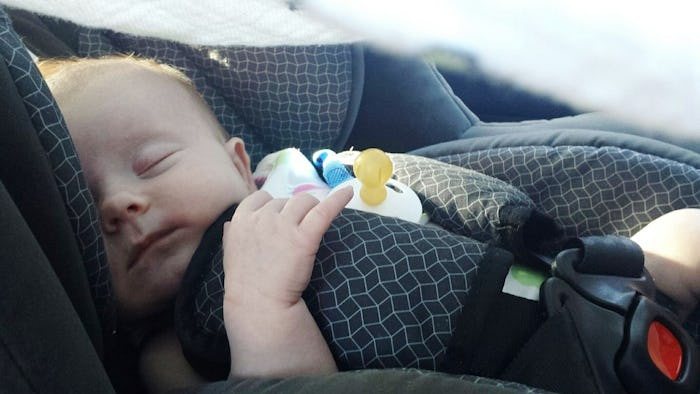As a parent, I always found car seats baffling. I wanted to make sure my kids were safe, and I would often get confused by the regulations. I never quite trusted my buckling abilities, nor anyone else's, for that matter. Which is why I was so relieved to see these updated car seat safety guidelines. They're clear, concise, and will hopefully reassure every parent out there who wants to know if they're doing it right.
The American Academy of Pediatrics (AAP) recently released a fully updated version of helpful car seat safety guidelines. The latest guidelines cover everything from the type of car seat each level of infant and child should be using, how to safely install both rear- and front-facing car seats in your vehicle, and helpful tips on booster seats for older children. If you're wondering what sort of car seat your baby should be using, the safety guidelines state:
- Infants under two-years-old should be in a rear facing car seat, or have reached the highest weight and height recommendation of their car seat manufacturer.
- Toddlers and preschoolers should stay in forward-facing car seats as long as possible, once they've outgrown their rear-facing seats.
- School-aged children under 4 feet 9 inches should use a booster seat.
- Children taller than 4 feet 9 inches and under 13 years old should be in seat belts in the back seat (they should always be in seat belts, of course, but children under 13 should remain in back seats).
According to the Centers for Disease Control and Prevention's report on child passenger safety in 2014, 602 children under 12 years old died that year in motor vehicle accidents. A further 121,350 were injured in crashes. Fortunately, the CDC also reported that between 1975 and 2014, child restraints saved an estimated 10,673 lives of children ages 4 and younger. The importance of proper car seat safety clearly can't be underestimated.
Following proper car seat safety guidelines can go a long way in keeping your child safe on the road. With that in mind, the AAP shared helpful tips on optimum safety for rear-facing car seats:
- Place the harnesses in your rear-facing seat in slots that are at or below your baby's shoulders.
- Ensure that the harness is snug (you cannot pinch any slack between your fingers when testing the harness straps over the baby's shoulders) and that the harness chest clip is placed at the center of the chest, even with your child's armpits.
- Make sure the car seat is installed tightly in the vehicle with either LATCH or a locked seat belt. If you can move the seat at the belt path more than an inch side to side or front to back, it's not tight enough.
- Never place a rear-facing seat in the front seat of a vehicle that has an active front passenger airbag. If the airbag inflates, it will hit the back of the car seat, right where your baby's head is, and could cause serious injury or death.
- If you are using a convertible or 3-in-1 seat in the rear-facing position, make sure the seat belt or lower anchor webbing is routed through the correct belt path. Check the instructions that came with the car seat to be sure.
- Make sure the seat is at the correct angle so your infant's head does not flop forward. Check the instructions to find out the correct angle for your seat and how to adjust the angle if needed. All rear-facing seats have built-in angle indicators or adjusters.
- Check the car seat instructions and vehicle owner's manual about whether the car seat may contact the back of the vehicle seat in front of it.
The AAP noted that there are five different types of seats that can be used as forward-facing car seats: convertible, forward-facing only, combination seats with a harness, built-in seats, and travel vests. If your child is being driven by someone else, like a care provider, there are certain rules that must be followed:
- All drivers must have a valid driver's license. In some states, school bus drivers need to have a special type of license.
- Staff-to-child ratios for transport should meet or exceed those required for the classroom.
- Every child should be supervised during transport, either by school staff or a parent volunteer, so the driver can focus on driving.
- School staff, teachers, and drivers should know what do to in an emergency, know how to properly use car seats and seat belts, and be aware of other safety requirements.
If you're planning on driving anywhere with your children, it's a good idea to consult the AAP's car guidelines — for your child's safety, and your own peace of mind.
